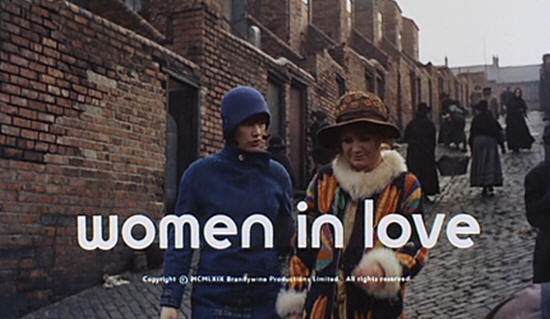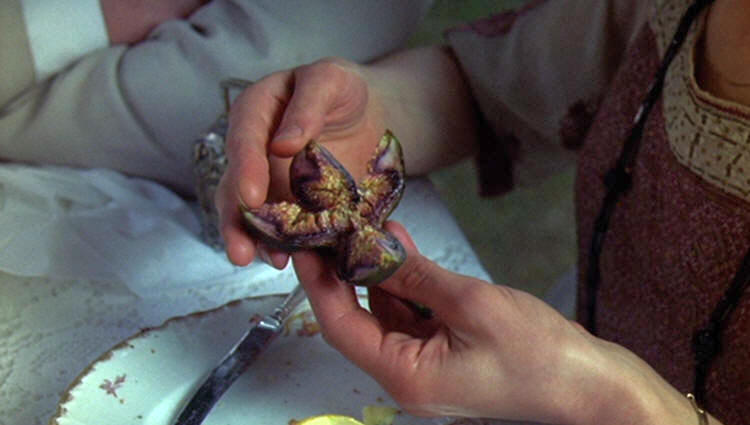|

|
"he appeared at a time when films were
becoming a little static and dialogue based and he sort of blew that wide
open" (Editor Michael Bradsell on Ken Russell from interview on DVD extras) |

Woman in Love, a period when Ken Russell brought out films that
challenged cinema, was a major critical and commercial success.
The Music Lovers continued his success and The Devils established him as a great mainstream director.
At one point his latest three films (The Music Lovers, The Devils and The Boyfriend) were showing at the same time on
London's West End
Women in Love from 1969 is based on DH Lawrence's 1920 novel and caused as much critical confusion as Lawrence
did in his day. The wrestling scene brought homo-erotic images
into the mainstream cinema [my phrasing here was used uncredited word
for word by an international news organisation]. But it became a major commercial success
Larry Kramer, the producer who also wrote the screenplay says
filming took 16 weeks and the film cost between $1.25 and $1,5 million- he
gives both figures (from DVD commentary). Michael Brooke states
Peter Brook, Jack Clayton, Stanley Kubrick and Silvio Narizzano were
initially approached to direct (from DVD notes).

As in Russell's later Rainbow he skips most of
the political aspects of Lawrence's book as well as the first world war
(there is a rabbit called Bismarck). DH Lawrence wrote The Rainbow
first then Women in Love, but Ken filmed The Music Lover first and
The Rainbow twenty years later.


Drowned lovers contrasted with the living.
The rest of the virgin and the anxiety of
the mistress.

Ken Hanke says "I’d certainly rank it in the top ten literary
adaptations of all time. It’s that rarest of adaptations in that it
captures the novel and comments on it at the same time. Russell has looked
at the novel as a kind of autobiographical wish-fulfillment. The
characters are Lawrence and his friends as he saw them- or maybe, as
Russell once corrected me, “as he would have liked them to be.” As a
result, the film is often as much about Lawrence as it is an adaptation of
the book. Take the garden luncheon where Lawrence’s alter-ego Rupert
Birkin (Alan Bates) embarrassingly recites the poem “Figs”- a poem (equating
the fig with female genitalia) by Lawrence that is not in the novel. But
you almost feel it ought to have been after you’ve seen the film"
(Mountain Xpress, 26 Jun 2012 (click
here).
The proper way to eat a fig, in society,
Is to split
it in four, holding it by the stump,
And open it, so that it is
a glittering, rosy, moist, honied, heavy-petalled four-petalled
flower.
Then you throw away the skin
…
After you have
taken off the blossom with your lips.
But the vulgar way
Is just to put your mouth to the crack, and take out the flesh in
one bite.
…
The fig is a very secretive fruit.
…
The
Italians vulgarly say, it stands for the female part; the
fig-fruit:
The fissure, the yoni,
The wonderful moist
conductivity towards the centre.
Involved,
Inturned,
…
One small way of access only, and this close-curtained from
the light;
Sap that smells strange on your fingers, that even
goats won't taste it;
…
And then the fig has kept her secret
long enough.
So it explodes, and you see through the fissure
the scarlet.
And the fig is finished, the year is over.
That's how the fig dies, showing her crimson through purple slit
Like a wound, the exposure of her secret, on the open day.
Like
a prostitute, the bursten fig, making a show of her secret.
That's how women die too.
|


The use of mirrors is typical of Ken Russell. As well as the
conflict between Gerard & Gudren and Rupert & Ursula, there is also
a gay undertone between Gerard and Rupert, hovering between sexual and
life-long friendship
John Russell Taylor in The Times, 13 Nov 1969, says "Whoever
had the idea of putting D.H. Lawrence and Ken Russell together,
it was a stroke of something like genius."
"Rarely has a great novel been more
lovingly, more sensitively or more knowingly brought to the screen"
(Arthur Knight, quoted in Jane Jaffe Young,
D.H. Lawrence on Screen, 1999, chapter 4).

Russell says the dance sequence was influenced by Isadora Duncan
(from DVD commentary) and Russell also made a documentary on Isadora
Duncan.

Early in the film Gudren says "I was born here and I will die here
until I fly away". But when she reaches Switzerland she says "The
minute I set foot on foreign soil I am transported". She has
outgrown Gerald and meets Loerke played by Russell regular Vladek
Sheybal. Producer Larry Kramer says Klaus Kinski was the first
choice for the role, but was too expensive" (from DVD commentary).
Loerke is gay, but Gudren and he bond, and in one scene imitate
Tchaikovsky, the gay composer, and his wife. This scene would come
back in Russell's next film The Music Lovers.

Gerald is not used to women taking control, and he is destined to
be alone on the snow in a cold frigid death.
Rupert laments the death and when Ursula says "You can't have two
kinds of love. Why should you? Aren't I enough for you" he
replies "You are enough for me as far as a woman can be".
All images from the film or the DVD extras.
|